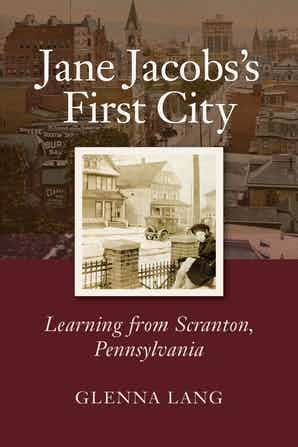
May 4, 2021 marks the 105th anniversary of the birth of Jane Jacobs, the urban activist/theorist/author from Scranton, Pennsylvania, where I was born and raised. The city will honor Jacobs, her ideas, and her influence May 4-8 with Observe Scranton: Jane Jacobs’s First City Festival, featuring in-person and online events presented by Center for the Living City and Marywood University. Maria MacDonald, a practicing interior architect and Program Director of Interior Architecture at Marywood, became the Center’s Executive Director last year.
A key part of the event will be the book launch of Glenna Lang’s Jane Jacobs’s First City: Learning from Scranton, Pennsylvania, published by New Village Press, and imprint of NYU Press. Lang is also the author of the 2009 book Genius of Common Sense: The Story of Jane Jacobs and The Death and Life of Great American Cities. The lecture and slideshow is part of the 2021 Jane Jacobs Lecture Series.
As I wrote last year and earlier, Jacobs’ ideas and influence have had considerable staying power. 2021 also marks the 60th anniversary of the publication of her most famous book, The Death and Life of Great American Cities, which had a special 50th anniversary edition published ten years ago. Lang’s book is a riveting, superbly-researched examination of the life of Jacobs through the lens of her formative years in Scranton, and how the influence of her early life continued until her death less than two weeks before what would have been her 90th birthday in 2006.
Given the importance of the viability of cities in Jacobs’s work, Lang in particular pieces together the Scranton of the years 1916-1934, when at the age of 18, Jacobs moved to New York City. Lang starts from Scranton’s founding in the 19th century, and brings the story up to the present day, with its ups-and-(many) downs of prosperity, ending on a hopeful note of optimism. She interviewed many people, including Jacobs’s family members, and also accessed numerous relevant and obscure documents and media articles published long ago.
Jacobs got her start as a published writer in Scranton as a reporter at what was then the morning newspaper, The Scranton Republican, after graduation from Scranton Central High School. Lang describes Jacobs’s role as a kind of internship/apprenticeship, where she honed her considerable powers of observation, and acted as a sponge for information and knowledge. Shortly after this experience, as Lang relates, “In November 1934, at age eighteen, she made a beeline for New York City, began her career as a writer, met her life partner, and became the well-known Jane Jacobs, whose ideas would indelibly affect the world’s thinking about cities.”
Lang notes how Jacobs, as she was growing up, was fascinated by the downtown area of Scranton. Lang also writes about the profound influence being a Girl Scout had on Jacobs, and how those values remained throughout her life. She devotes Chapter 6, The Liberating Ideology of the Girl Scouts, to the topic. “In Girl Scouts,” Lang writes that “she practiced observation of nature and applied the same skills to studying the city.” And crucially that membership “helped develop her interests and instilled a means of investigating the world as well as a sense of a woman’s boundless possibilities that she would carry with her throughout her life.”
The origin story of Jacobs holds multiple implications for people today, no matter their age, gender, or whether or not they live in a city. Well before today’s terminology, she was an influencer of the first order. She succeeded without a college degree, but with powers of self-learning that many would do well to emulate, whether or not they hold academic degrees. She also succeeded in an even more male-dominated era than today, and as a published author was somewhat of a late bloomer, given that The Death and Life of Great American Cities was published when she was 45.
Jane Jacobs’s First City: Learning from Scranton, Pennsylvania also has meaning for me because of my experience living there from birth until moving at 17 to Washington, D.C., to attend The American University. Many of the institutions, buildings, streets, and neighborhoods in the book are familiar. Her family home at 1712 Monroe Avenue in the borough of Dunmore is a short car ride from where I lived in east Scranton (‘the Hill Section’) near Nay Aug Park. Some of the photos and illustrations made me intensely nostalgic. Jacobs’s father, Dr. John Decker Butzner, practiced medicine in the Medical Arts Building, which I frequented as a boy. I graduated from the nearby Scranton Central High School, albeit 35 years later than Jane. My father, Paul Rosenstein, who died in 2011 at 95, also graduated from Central, and as it turns out, in the same year as the then Jane Butzner. I regret that I never asked him whether he knew Jacobs during those years, or if perhaps he knew others in the Butzner family.
With its mixture of problems and opportunities, Scranton remains in the news, particularly as the birthplace of President Joe Biden. “The sepia-tinted myths often overshadow its contemporary truths, making it as much an idea as a locale,” Karen Heller writes in the July 23, 2020 Washington Post article “Scranton became shorthand for the past. Its reality is far more complicated.” Glenna Lang’s new book emphasizes that perhaps the ongoing story of Scranton holds clues to how cities in the United States and elsewhere can regenerate and reinvent themselves, and just as importantly, how the story of Jane Jacobs might inspire individuals to do the same.
